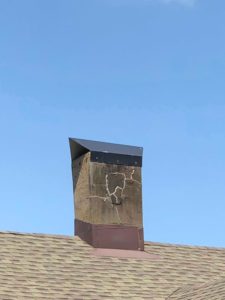by Mark Hudson | Mar 22, 2018 | Chimney Discoloration
Your chimney is not only used for heat and comfort, but also aesthetics and beauty. Just as a chimney can save homeowner’s money in utilities and add value to the property, it can just as easily decrease the value if it’s neglected or damaged. When your chimney becomes discolored, it becomes obvious there is a problem. Oftentimes, the color can tell you what the problem is.
Stains on the Exterior
White Stains – When water passes through the masonry, it leaves behind minerals like water molecules. If you have white stains on the exterior surfaces of your masonry chimney, your chimney is being affected by water. This is especially common in ocean regions where there are a lot of salts in the air, such as in our service area.
Red Stains – Red stains are common toward the top of the masonry chimney. They are a result of a corroded and rusted chimney cap. A damaged chimney cap may allow water inside, allowing the rusty water to run down the chimney face.
Stains on the Interior
Green/Black Stains – Noticeable stains on the inside of the chimney system are often a result of water damage. Greenish/black stains are a direct result of mold and mildew. The bacteria and spores are likely present in the air and affecting the quality of the air you breathe.
Black/Brown Stains – Caused by soot and creosote, these common stains are mostly found in the firebox. A regularly cleaned and maintained fireplace will not stain. Soot stains may be an indication of a dangerous overproduction of carbon monoxide in the chimney.
Stains on the masonry are not the only kinds of stains that may indicate a dangerous hazard. If you have any type of heat appliance including gas fireplaces or electric heaters, you should be aware of the surrounding space. For instance, if the wall near your heat appliance appears discolored, the heat is affecting it. Most of the building materials that make up your home are flammable, including wood, insulation, wiring, wall coverings, and window treatments. When heat affects the area around the appliance, it still weakens the beams and materials over time, drying them and making them brittle while increasing their fire risk.
No matter what the discoloration or where it occurs, it indicates a problem. If you have noticed a change in appearance, a stain, or otherwise discolored area of the chimney’s masonry or area nearby, you should call a professional for an assessment. Hudson Chimney provides important services such as chimney inspections that can keep your family safe. Remember to schedule your inspection annually, especially if you notice a change or a problem in your system.
Call Hudson Chimney at 904-282-4159 or contact us online!
by Mark Hudson | Aug 11, 2016 | chimney maintenance
If you have noticed a discolored stain on the exterior of your chimney, you have good reason to be concerned. Not only is discoloration on a chimney exterior unattractive, but it also can signal a problem that could lead to more chimney damage. Different colors can signify different problems, and it is important to know which colors appear with each issue to troubleshoot the needed repairs. For over 30 years, Hudson Chimney has been serving the chimney maintenance, repair, and installation needs to residents of the Jacksonville area, and you can trust us to diagnose the cause of the discoloration and fix the problem behind the stains. Our chimney technicians have been certified by the Chimney Safety Institute of America (CSIA), so you are getting both experienced and trained chimney service from us. We would like to tell you the possible causes behind different colors of stains on the exterior of your chimney to help you know more about the reason for the discoloration.
WHITE STAINS
If the discoloration you notice on the outside of your chimney is white, you are seeing efflorescence stains, which is formed by mineral salt remaining on the bricks and mortar from the evaporation of water. While efflorescence could be caused by rain blowing against the chimney during a storm, this discoloration often signifies the existence of a chimney water leak. Hudson Chimney can inspect your chimney to find the leak, repair the source of the leak, and remove the stains. To prevent water penetration of your chimney and efflorescence, we recommend our waterproofing service that creates a barrier to water penetrating the bricks and mortar and also keeps efflorescence from discoloring your chimney.
BLACK OR BROWN STAINS
While darker stains can also be the result of water penetration in the case of mold, Hudson Chimney finds black or brown chimney stains to more commonly be discoloration from creosote or soot. The appearance of creosote running out of the top of your chimney should be taken seriously as a strong risk of a chimney fire. Creosote is extremely flammable, and if enough creosote is in your chimney that it is pouring out, you definitely have enough creosote inside to ignite a chimney fire. If you have a gas fireplace, black or brown stains are not creosote but soot and are an equally important warning sign. According to Inspectapedia, soot stains should alert you to a dangerous situation of a high risk of the overproduction of carbon monoxide inside the chimney. You should contact Hudson Chimney as soon as possible when you see black or brown stains to have us take care of these safety hazards.
RED STAINS
When you see red or reddish-brown discoloration on the exterior of your chimney, you have an issue with rusting. The most common cause for rust stains is corrosion damage on your metal chimney cap. If your chimney cap has suffered from corrosion, it could be damaged by cracks that will allow water to leak into your chimney to cause even more damage. Hudson Chimney can help by installing a new chimney cap that will protect your chimney from water leaks.
The color of stains on the outside of your chimney can alert you to a serious chimney problem that could make your fireplace unsafe to use. Contact us at Hudson Chimney to schedule an inspection to determine the source of discoloration and make the necessary repairs.

